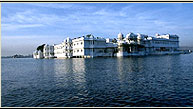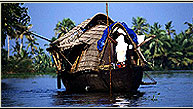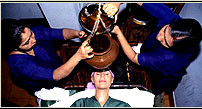-| Panda | -

Located
at 5 kms. northwest of Dalsingh Sarai in the district of Samastipur, Bihar,
this site belongs to the period of pre-N.B.P. phase. The excavations at this
site have revealed a 6.9 mtrs. deposit divisible into 9 different layers which
include different colours of soil, i.e., yellow soil, blackih soil, greyish
soil. Based on these layers the findings of the site are separated as the belongings
of different periods namely, period I, period II and period III.
There are also findings of distinct ceramic tradition :-
- black and red ware ,
- red ware,
- grey ware and
- black ware.
The characteristic shape in black and red ware comprises of bowls and dishes
on stands. The antiquities also include bone objects, such as arrow heads and
stylus. There are also the findings of terracota objects such as pendents and
vase shaped beads.
Among the terracota objects, there are also findings of human and animal figurines,
wheels hop-scotches, sling balls and ear lobes. The animal figurines include
hump bulls and rams stricking. The period II findings have revealed many bone
objects that include bangles, beads, points and arrow heads. This phase has
also yielded rings and rods made of copper.
The iron objects include nails, arrowheads. Beads made of semi-precious stones
such asJasper, Agate, Carnilian and crystal have also been discovered that belong
to this period.
The period III belongs to Sunga-Kushna period having the deposit of 1.25m to
1.50m,the findings of this phase includes Red ware,Grey ware & Black ware,
pottery shapes include dishes,spouted vessels,bowls,handled vessels & lids.
The antiquites ofthis period includes inscribed terracotta token,A copper coin,copper
rings,terracotta human & animal figurines,beads,sling ballshop scothes bangles.wheels,corn-rubbers,glass
bangles,stone pastles & bone point. There have been a trail of excavations
carried out at Panda.
This year ASI excavations at this site is likely to take place in the month
of Dec 2001 to Feb 2002. The main objective of this years excavation is to unravel
the cultural sequence of the site & compare it with the finding of previous
year.




 Located
at 5 kms. northwest of Dalsingh Sarai in the district of Samastipur, Bihar,
this site belongs to the period of pre-N.B.P. phase. The excavations at this
site have revealed a 6.9 mtrs. deposit divisible into 9 different layers which
include different colours of soil, i.e., yellow soil, blackih soil, greyish
soil. Based on these layers the findings of the site are separated as the belongings
of different periods namely, period I, period II and period III.
Located
at 5 kms. northwest of Dalsingh Sarai in the district of Samastipur, Bihar,
this site belongs to the period of pre-N.B.P. phase. The excavations at this
site have revealed a 6.9 mtrs. deposit divisible into 9 different layers which
include different colours of soil, i.e., yellow soil, blackih soil, greyish
soil. Based on these layers the findings of the site are separated as the belongings
of different periods namely, period I, period II and period III.